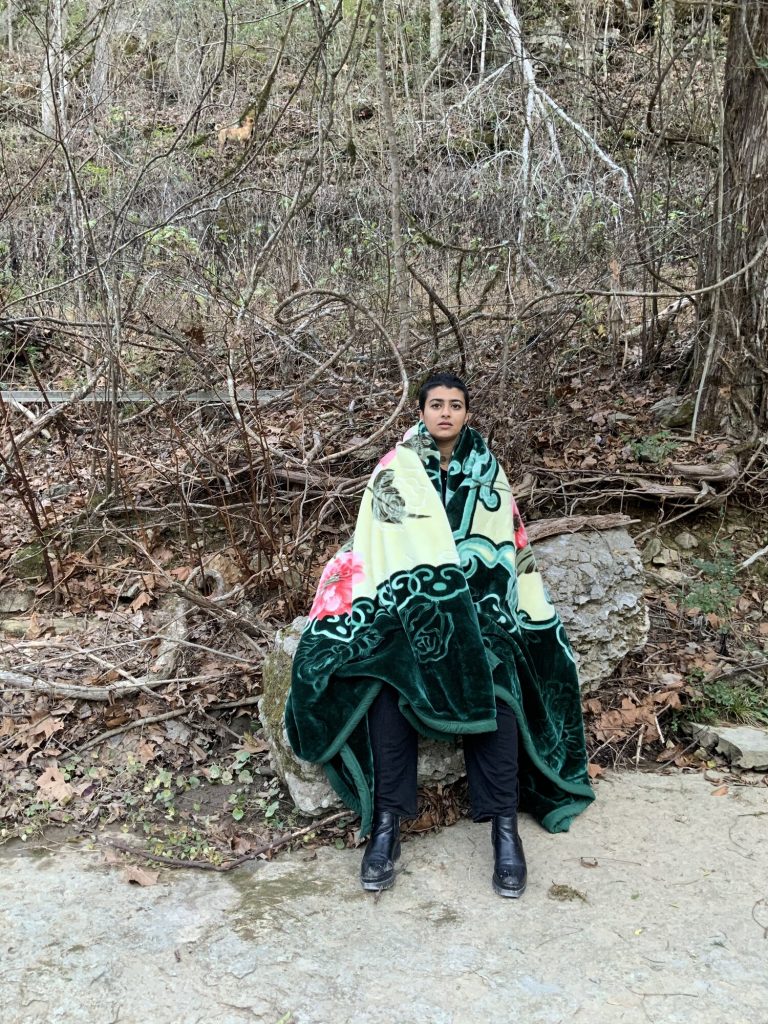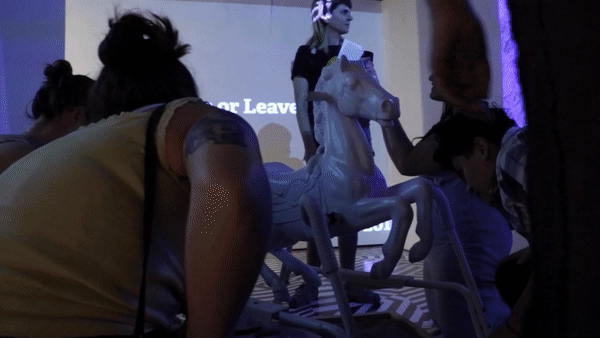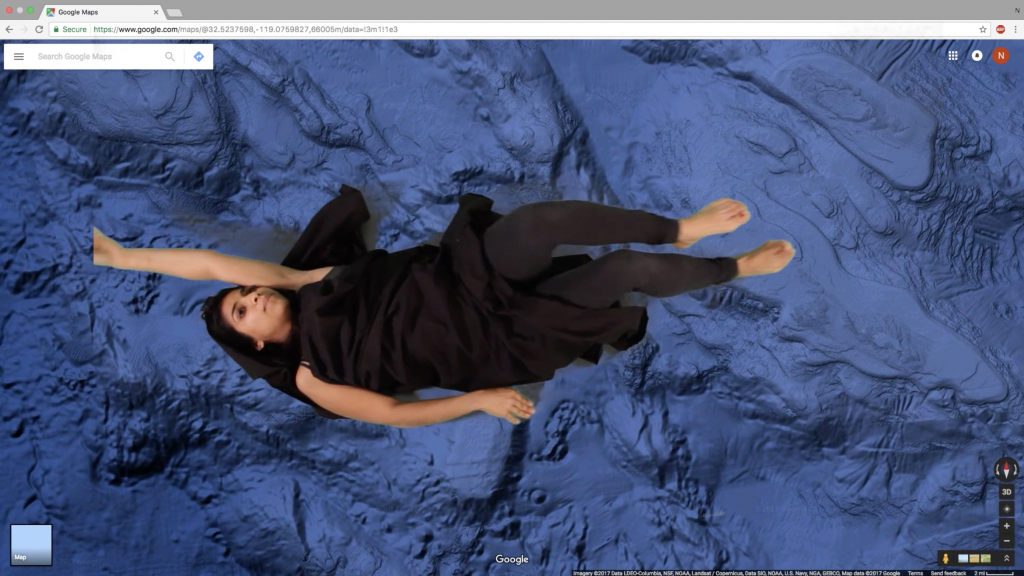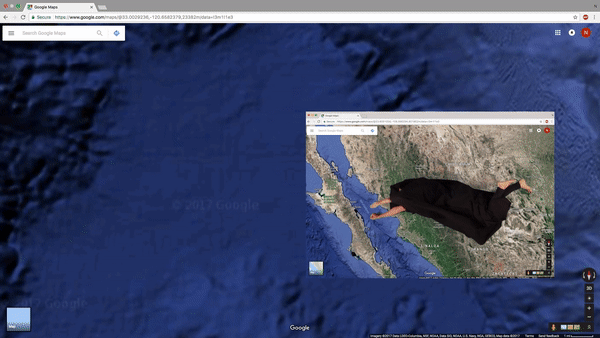Interview by Sami Abdelbaki
Featured video: ‘Here and There’ by Nassem Navab
photos by Sara Tran Luu and The Museum of Contemporary Arts in Tucson, Arizona
This article is part of the “Hopefully Tomorrow” issue
“I never want to criticize my country through a western optic lens but at the same time I’m an artist and my job is to put a mirror back to my country,” tells me artist Spike Bahermez about their art.
Spike Bahermez is an experimental performance artist, immigrant-activist and educator raised in Abu Dhabi, UAE. A former Fulbright scholar, they hold a Bachelor of Arts in Theater from New York University and a Master of Fine Arts in Theater from Towson University. Their identity as a queer non-binary Muslim drives their artistic compass, whether it be in short film, interactive theatre, performance art, tackling themes of immigration, identity, and societial taboos.
Drawing inspiration from their experiences as an immigrant, Bahermez enjoys playing around with the relationships between the body, the audience and the space. They chose immersive theatre as an art form to experiment with these concepts, like in their piece, Bayt, an immersive performance exploring trauma, childhood and intimate spaces inspired by the artist’s personal stories and experiences growing up in Abu Dhabi.
Bahermez’s immersive escape room and installation, “Absher/Rejoice!,” went on display in April 2019 in the Museum of Contemporary Art in Tucson, Arizona. It was inspired by a mobile application aimed to make Saudi state services more accessible to citizens. The app sparked controversy when it was being used by Saudi men to track their wives, daughters, and domestic workers. showing that the guardianship system in Saudi Arabia still imposes a major threat to women and people from the LGBT+ community. A hashtag, إسقاط_التغيب_والعقوق_مطلب#, is trending on Twitter protesting against the guardianship law which enables parents to report their children if they move out to live independently or travel without their agreement.
Talking over Zoom, we discussed more about their installation, method of creating art, and upcoming projects.

Spike Bahermez photographed by Saba Taj
How would you describe your work?
I describe my work as both experimental performance art and immersive theatre. It’s somewhere in between. I did my undergraduate, my bachelor’s at NYU in Abu Dhabi and then I got a Fulbright scholarship to do master’s, an MFA in Baltimore at Towson University in theatre, and that’s where I got to explore immersive theatre on my own in terms of creating and working with people and networking.
I describe my work as mainly spatially concerned; It’s concerned with dynamics of space and the social relations around it. These concerns come into my work about displacement, exile, and longing for home. I also make work about governments, their people, and the relations between them; these relationships interest me directly because I never felt like I belonged in the country where I grew up.
How do your mixed methods and themes of space come into your work, Absher/Rejoice?
Absher/rejoice is an immersive escape room and a piece of theater work. It’s also an installation that engages the audience as an active participant. Absher is a mobile application endorsed by the Saudi government that allows Saudi citizens and residents to access Interior Ministry services like renewing passports, applying for ID cards, and paying traffic tickets. But because of the guardianship system, one of the features in the application was allowing guardians to grant or deny permission for women and children to travel abroad and obtain a passport and look at where their wives and daughters were going. It’s terrifying to live under a guardianship system where you’re restricted from doing basic things without your guardian’s permission. It takes away your humanity.
When the guardianship element of travel applications is integrated into an app, it is futuristic in a dystopian and terrifying way. It marks where we are right now; these technologies keep people, and specifically men, in power. I know of several women in Saudi Arabia who stole their father’s phones in order to change the tracking systems and get themselves to the airport without their fathers knowing. It’s also terrifying for queers and people who must live with fear, or who feel like they’re always under surveillance and the risk of imprisonment or disappearing if someone makes a simple call.
It’s a hard life to navigate space, and that’s what Absher (my installation) was about. It was about the experience of these queers and revolutionaries always being under surveillance. I turned it into a game to simulate what experience might be like from exile, and to introduce this concept to an audience made up of many westerners in the US.

Video/photos by Sara Tran Luu and The Museum of Contemporary Arts in Tucson, Arizona
Building on that, I’m assuming your audience was mostly Americans. What was the message you wanted them to leave with?
I don’t know if I necessarily have messages for my audience. I create work that can be perceived in many possible ways. In Rejoice, I was setting the boundaries and circumstances of the space they’re moving through and experiencing. I feel like, by making them active participants in the game, they are put in a position of both responsibility and vulnerability that they could interpret in the context of Gulf countries.
I never want to criticize my country through a Western lens, but at the same time, I’m an artist and my job is to put a mirror back to my country. There’s no way that a participant can come out of it and claim “I know what it’s like in a Gulf country!” It’s not going to happen. But they might be able to empathize with a person who experienced this in a Gulf country, who felt both scared at points and love for this place. There are a lot of mixed feelings that they’re interpreting through the space, but it’s also very exciting.
Can you walk us through the logistics and stages of the installation? What would this experience feel like for audiences?
The show happened over four nights with three shows per day, and there was a capacity of ten people per group. I gave the audience 15 to 30 minutes to make it through the maze, and that was really on their own time. Some of them took up to 30 minutes and others were maybe 20 minutes. It was kind of a difficult game, but all groups made it through.
There were four different rooms. The first one was a waiting room where the main puzzle was to look through time and at all these clocks, and get through it using math. This was aimed to inspire fear that a lot of people experience in waiting rooms of judicial systems in the Gulf, and the pressure of being called upon. Once they got through the first room, they were into the “heritage fantasy room”. The concept of this room came from the idea that many of those countries construct new spaces that project an image of heritage, rather than continuing to practice their heritage in traditional spaces. Cultural centers in Abu Dhabi are a good example of this. The room had many works by artists from the region projected onto the walls, and people had to dig through this little sandbox to get through to the next room. The third room was “a sensitive matter of national security,” where the audience looked through an official’s office. Everything was clad in bubble wrap: the walls, the tables, the floor, everything you touched. Putting ten people in a bubble wrapped room makes you anxious. You’re supposed to be working together to find the clue to get out, but you can’t help but hear every single tiny noise that you’re making … that was the point. Once they found the clue in there, they got to the last room where they could just sit and listen to this performance that I’ve been performing for a while called, “the Munfalitat Manifesto.” The performance is a call to action and a love letter to my own queer people.


First photo: A screenshot from video ‘Here and There’ by Nassem Navab, a video art piece that draws out the tensions that exist between the promises of representation and our current political climate. This video art piece is created using screen captures of Google Earth to explore different bodies of water and land throughout the middle east, ending in the Los Angeles river. Second Video/photos below by Sara Tran Luu and The Museum of Contemporary Arts in Tucson, Arizona
A lot of your work uses unconventional and experimental forms of art depending on the subject. Why did you choose to make this installation immersive?
I like to think of the theatre as a relationship between three things: the actor, the audience and the space. All I’ve ever wanted to do in my work was to replace the functions of these things. What if the space acted as an actor? What if the audience were active participants and the actors? What if the actors were the actual space and they weren’t people in that space, they were physical objects? And I’d love to think that there’s no such thing as an “aspatial” social relationship. Everything is connected. And thus, as artists, as architects, as citizens, we must intervene in some way to make it more equally distributed.
Working on an interactive theatre performance is never an easy task to manage, both artistically and logistically. Who helped you out with the installation?
I designed the space, and I had a team that helped me put it all together Adam Cooper Telan was the sound designer and Jude Jehad was an actor and video artist. Jude was the only actor and so important because they helped people go from one room to another, if necessary, and was also an embodied clue in the space.
Immersive theatre usually receives mixed reviews and feedback, it’s not everyone’s cup of tea. What kind of feedback did you receive?
Most of my work, especially immersive theatre, is about my country, my culture and my values and my audience is mostly Americans. People are usually telling me their own experiences on how excited or scared or confused going from one room to another or how the lock didn’t work or they have to cheat the game and telling me their own experiences, which to me is fruitful but it’s still not the kind of feedback that I would’ve wanted from my people. I really wanted a queer Arab person in that room, especially if they grew up in the middle east. That is the kind of dynamic and conversation that I want to be having with my own people as much as I do want other people to interact with it.
What are your upcoming projects after the pandemic shook the world?
I’m shifting gears because of the pandemic. I can’t really have people locked up in one room together and I’m not one for virtual immersive work. I’m currently collaborating on launching an artist residency with a Queer Land project in Tennessee to host other artists and have them have the space to make the work that they want to be making and we’ll be providing them with a space to stay. Hoping to launch it in February.
Anything to add before our last question?
I do want to add that the installation was inspired by this installation called “Dazzled”. It was about these military ships in WWI, and the ships had big stripes and these patterns that made you not know whether these military ships were going away from you or coming towards you. It really did start the question of what is my country hiding from me? What is my country protecting me from? Those questions did start where Absher came from. The original floor in Dazzle was in the performance itself in order to confuse the audience.
What is home to you?
I think “home” to me tends to be the memories which my home country left me with. All those memories are very visual, I can still smell things and feel things and hear things even in the middle of the night where it’s completely dark. I can still feel the love and intense longing and at the same time that anger. I have so much anger for my home country and I wish there was a way that I could be part of that change and it’s hard to think of that in exile. Home to me right now is memories that I try to bring up as much as I can through my artwork or through my daily life or things that I touch or smell or play with.

